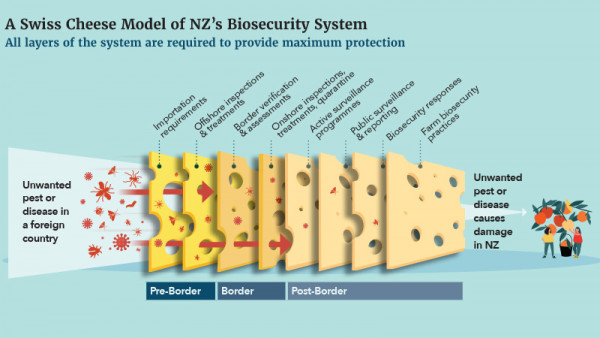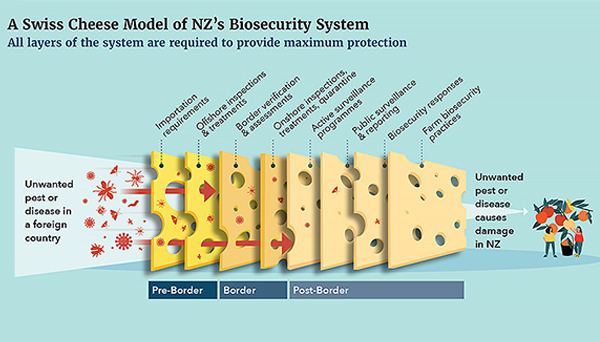A guide to New Zealand’s biosecurity system
25 May 2022
Part 1: All layers of the system are required to provide maximum protection
Written by Eve Pleydell, HortNZ risk policy advisor
First published in the May 2022 issues of The Orchardist and NZGrower.

Key messages:
- New Zealand’s biosecurity system is made up of many layers
- Multiple people and organisations are required for it to function well
- Primary producers play important roles across the system
During a recent biosecurity presentation, a speaker suggested that the Swiss cheese model could be used to illustrate how the different layers of the biosecurity system work together to provide protection. In this article I’m taking that idea and exploring it further.
The Swiss cheese model was developed in the 1990s by the psychologist James Reason to illustrate how accidents may happen. In this model, each layer of defence against an accident is illustrated as a piece of Swiss cheese with random holes. The slices of cheese are arranged in a line one after another and accidents happen when the holes line up from one end of the line to the other. While this model has been applied and maybe even misapplied to many different situations, it can be used to provide a simplistic, but helpful overview of the biosecurity system.
It is tempting to think of the biosecurity system as being the things that the Ministry for Primary Industries (MPI) does at the border to protect New Zealand from being invaded by unwanted pests and diseases. That is certainly one of the most public facing aspects of the biosecurity system, but equally important things happen offshore (commonly referred to as “pre-border”) and onshore here in New Zealand (commonly referred to as “post-border”). In a series of short articles, we’ll take a closer look at each of these parts of the system, but for now let’s consider some of the holes in the biosecurity cheeses.
In his original model, James Reason described two types of holes, which he termed “active failures” and “latent conditions.” Thinking about how this applies to biosecurity, a system failure could be considered an active failure. This could be something arriving in New Zealand that the system as a whole was not expecting and was unprepared for. The importation regulations did not cover it, it was not detected at the border, there was no active surveillance to detect it, normal farming practices did not stop it from spreading, and no one in New Zealand spotted it or reported it before it started to cause damage.
Another type of active failure could be human errors such as treatment failures, inadequate inspections, or people in New Zealand not reporting something unusual. Illegal activities and non-compliance with biosecurity regulations could also be viewed as an active failure. These can be deliberate actions of people, like attempting to smuggle plants or plant material into New Zealand from other countries. But non-compliance can also be non-deliberate, think of the exhausted parent travelling with a child who at some point in the journey has put a piece of fruit into the child’s bag and forgotten that it’s still there.
Latent conditions are circumstances and things that put pressure on the system. There are many of these and they are often happening at the same time. Examples are things like increasing volumes of imported goods, a global increase in online shopping, or increasing numbers of passengers as our borders reopen. Circumstances changing in other countries may also alter the risk posed to New Zealand by pests and diseases in that country. A major flooding event in Japan, as an example, may cause parked vehicles waiting to be exported to New Zealand to be moved to a different site where they are unexpectedly exposed to an invasive pest such as brown marmorated stink bug. An outbreak of a pest or disease in another country may also result in contamination of imported goods.
On a longer-term scale, changes in climate enable some pests and diseases to spread to countries that they were not in previously. Changes in the biology of a pest or disease may also mean it becomes capable of avoiding the protection measures in place; consider an insect that has developed resistance to the commonly used pesticide. Domestic issues here in New Zealand can also influence the biosecurity system, economic or other pressures may drive up the rate of non-compliance as people look for opportunities to relieve the pressure they are under. Remember the deliberate smuggling in and release of a lethal rabbit virus in the late 1990s.
To keep New Zealand protected within this complex web of challenges is a big job that no single organisation can manage on its own. Over this series of articles, we’ll take a look at the different parts of the system and how they are adapting to meet some of these challenges. We’ll also look at the ways that primary producers can contribute to the overall resilience of the system, from knowing the importation requirements, to demonstrating good biosecurity practice at the border, reporting the unusual, and keeping their own farms bio-secure.
MPI’s Ko Tātou This Is Us website is also a good resource: Ko Tātou This Is Us | Biosecurity - Keep NZ safe from pests and diseases.

